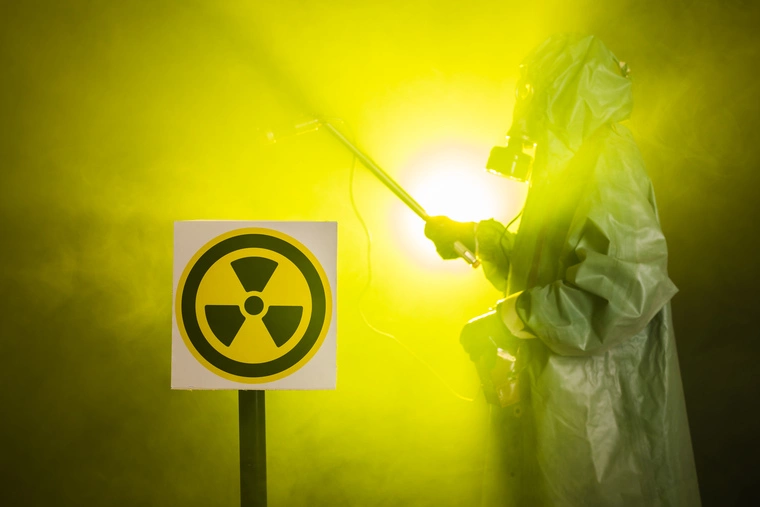Scientists from the University of Sheffield and the University of Hawaii have developed a new technique for remotely monitoring nuclear reactors using oscillations of antineutrinos.
This innovative approach could revolutionize nuclear safety and non-proliferation efforts by offering a non-intrusive method for tracking reactor activities from long distances.
“Antineutrinos from nuclear reactors have the potential to be used for reactor monitoring in the mid-to far-field under certain conditions,” wrote researchers involved with a new study detailing the findings. “Antineutrinos are an unshieldable signal and carry information about the reactor core and the distance they travel. As antineutrinos carry information about their distance of travel in their energy spectrum, the analyses can be extended to a spectral analysis to gain more knowledge about the detected core.”
Nuclear power plays a crucial role in global energy generation. However, concerns over safety, reactor misuse, and material diversion for weapons proliferation persist. With an expected 80% increase in nuclear capacity by 2050, as predicted by the International Atomic Energy Agency (IAEA), safeguarding reactors has become more urgent than ever.
Traditional methods of monitoring reactor operations, such as on-site inspections and item accounting, are effective but limited, especially in ensuring compliance with nuclear non-proliferation treaties.
Enter antineutrino detection, a technology that offers a new frontier for reactor monitoring.
In a study published in AIP Advances on October 1, 2024, the research team, led by Dr. Steve Wilson, a research associate in particle physics and particle astrophysics at the University of Sheffield, explored the potential of using antineutrino emissions to track nuclear reactor activities from mid- to far-field distances.
The team’s analysis, based on a detector prototype using a water-based liquid scintillator, offers promising insights into the technology’s ability to remotely detect reactor signals from underground without accessing the reactor complex.
Antineutrinos: Nature’s Unshieldable Signature
Antineutrinos are subatomic particles produced in vast quantities during nuclear fission. Each fission reaction inside a nuclear reactor produces a flux of antineutrinos that cannot be shielded, making them an unmaskable signal that can carry information about the reactor core.
These particles travel vast distances, carrying vital data about the power output, core composition, and even the distance between the reactor and the detector.
The concept of using antineutrino detection for reactor monitoring isn’t new. Previous studies have demonstrated the viability of short-distance reactor monitoring using antineutrinos, but this latest research takes it a step further.
By focusing on antineutrino oscillations—a quantum phenomenon where the flavor of a neutrino changes as it propagates through space—the team developed a spectral analysis technique capable of determining the reactor’s location without prior access to the facility.
“Once produced, neutrinos do not always remain in a single flavor,” researchers explained. “They can oscillate in a distance- and energy-dependent manner, with both the emission and dominant detection mechanism for reactor neutrinos involving electron-flavor antineutrinos.”
“By obtaining the energy spectrum of electron antineutrinos from a source, information about their distance of travel can be determined alongside the reactor power and core composition. This can be used to identify the source of a reactor signal or verify a known signal by confirming that the spectrum is as expected.”
Detecting Nuclear Power Reactors from Afar
In their study, the researchers applied their technique to real-world scenarios, examining reactor sites in the United Kingdom and France. Using a hypothetical detector located at the Boulby Mine in the UK, the team simulated reactor signals from nearby and distant reactors, including Hartlepool, Heysham, and Gravelines.
The detector, a water-based Cherenkov detector doped with gadolinium, was designed to capture the subtle oscillations of antineutrinos as they traveled from the reactor. By performing a Fourier transform analysis on the antineutrino spectrum, the team could determine the distance between the reactor and the detector with impressive precision, even from hundreds of miles away.
However, the study highlighted certain limitations in the current detector design. While the technique showed promise, the existing water-based detector struggled to monitor distant reactors within a reasonable timeframe.
Based on the number of background uncertainties, it would take 21 years to determine the range and complete spectrum of the Heysham complex, located 93 miles (149 kilometers) from the detector site. More distant reactors, such as Gravelines in France, 274 miles (441 km) away, would require over a century of monitoring to yield useful data.
Despite these limitations, the study provides a strong foundation for future advancements in antineutrino detection. The team believes that other detector designs, such as the JUNO liquid scintillator detector or the proposed Theia water-based detector, could significantly reduce observation times and improve detection precision.
Both JUNO and Theia promise superior energy resolution, which could make shorter-distance reactors easier to monitor while improving long-range detection capabilities.
Advancements in antineutrino detection have significant implications for global nuclear security. The technology could serve as an early warning system for detecting clandestine reactor operations or unauthorized fuel activities if refined and deployed at scale.
It could also complement existing safeguards by providing an independent verification tool, ensuring compliance with international treaties such as the Treaty on the Non-Proliferation of Nuclear Weapons (NPT).
Ultimately, Antineutrino detection offers a revolutionary, non-intrusive method for monitoring nuclear reactors remotely, paving the way for enhanced global security. With the potential to complement existing safeguards and provide real-time insights into reactor activities, this technology could become a cornerstone of future nuclear safety initiatives.
By refining detector technology and improving detection precision, scientists hope this breakthrough will lead to practical applications that protect against nuclear proliferation while fostering greater transparency in global nuclear energy programs.
“The detector is unable to practically range any of the reactors in the UK’s fleet,” researchers concluded. “However, the analysis shows potential when other detector designs are considered. By applying this technique to a different detector design, such as JUNO or Theia, ranging could be performed in a more reasonable time. This could allow it to be an extra tool for non-proliferation as it provides extra information on top of existing analysis techniques.”
“In many ways, what surprised me most is that this is not actually impossible,” Dr. Wilson added.
Tim McMillan is a retired law enforcement executive, investigative reporter and co-founder of The Debrief. His writing typically focuses on defense, national security, the Intelligence Community and topics related to psychology. You can follow Tim on Twitter: @LtTimMcMillan. Tim can be reached by email: tim@thedebrief.org or through encrypted email: LtTimMcMillan@protonmail.com

